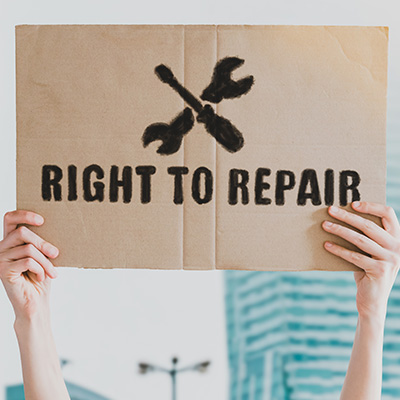 The Right to Repair movement has evolved from a simple idea into a full-fledged campaign, with numerous states enacting measures to enhance the rights of consumers and businesses who use various technologies daily. Let’s take a moment to assess the current status of this movement and explore what it means for businesses.
The Right to Repair movement has evolved from a simple idea into a full-fledged campaign, with numerous states enacting measures to enhance the rights of consumers and businesses who use various technologies daily. Let’s take a moment to assess the current status of this movement and explore what it means for businesses.
The Right to Repair has Two Key Objectives:
Objective #1 – Safeguarding Consumer Rights
According to the Public Interest Research Group, a nonprofit advocating for societal benefits, restricted repairability primarily serves to bolster service contracts and the profits reaped by manufacturers from them. In essence, manufacturers can increase their earnings from service contracts by limiting consumer options for repairing their technology, either independently or through third-party providers. They achieve this through the use of specialized components such as proprietary screws, exclusive tools, software constraints, warranty violations, and withholding repair manuals. This strategy ensures that only the manufacturers themselves can service their products (if they offer such services at all).
By limiting consumers’ ability to repair their own technology, manufacturers encourage the idea that technology must be replaced, leading to increased profits through service contracts and continual hardware sales. This applies to a wide spectrum of business technologies, from office computers to medical equipment, HVAC systems, and agricultural machinery, all susceptible to these artificial limitations.
Objective #2 – Protecting the Environment
The practice of replacing technology each time it malfunctions is an environmental catastrophe. Most discarded technology ends up in landfills instead of being properly recycled. This not only constitutes a wasteful practice, but many electronic devices contain materials harmful to the environment and our communities. The relentless production of new hardware to replace devices that are often rendered obsolete by manufacturer-imposed software locks exacerbates the problem. The manufacturing of new components consumes valuable resources that need not be expended.
In 2019 alone, 53.6 million tons of electronics were disposed of, resulting in a loss of $57 billion in various materials like copper, gold, platinum, and silver. Moreover, many of the materials used in computing components are hazardous to human health. Mercury, for example, is present in monitors, PCBs, and smart bulbs, and can harm the human nervous system.
E-waste is undoubtedly a significant issue and is steadily growing. In 2020, the United Nations reported a 21% annual increase in e-waste. While making it easier to repair computers and electronic hardware won’t entirely solve this problem, it would certainly contribute to a substantial reduction.
Current Status of the Right to Repair Movement
Unsurprisingly, the idea that consumers should have the right to repair their belongings has gained momentum, both in terms of public support and legislative action in the United States and Europe.
In 2022, New York became the first U.S. state to enact a Right to Repair law, obligating manufacturers to provide consumers with the necessary tools and information for repairs, with other states following suit. In September of this year, California passed the most comprehensive legislation in the nation, compelling manufacturers to offer all essential resources for repairs and banning digital locks.
Across the Atlantic, the EU proposed a law in March mandating manufacturers not only to provide access to tools and materials but also to make spare parts available for a decade. As of the present moment, negotiations continue, but it is expected to pass in 2024.
Challenges to these Laws
Predictably, lobbyists have been working to oppose or limit the impact of these laws. Many state laws include exemptions that specifically exclude enterprise computing devices. A few months ago, the automotive industry, known for small, independently-owned shops and DIY repairs, announced an agreement that seemed to commit to providing tools and resources for small shops to repair vehicles and their increasingly computerized components. However, key representatives of repair shops and aftermarket part suppliers were not involved, and there is no effective means to enforce these new standards.
Furthermore, as vehicles become more advanced, small shops are priced out of providing services due to the need for specialized (often subscription-based) tools and training.
In conclusion, the Right to Repair movement faces significant challenges and uncertainties. Only time will reveal its ultimate outcomes.
We’re Committed to Supporting Your Business’ Technology
While there are limitations to what we can do (as mentioned regarding software locks), Ashton Solutions is here to assist your business in maintaining and prolonging the life of its technology. We can repair what’s feasible and provide guidance to help your technology last longer. For more information, give us a call today at 216.397.4080.





